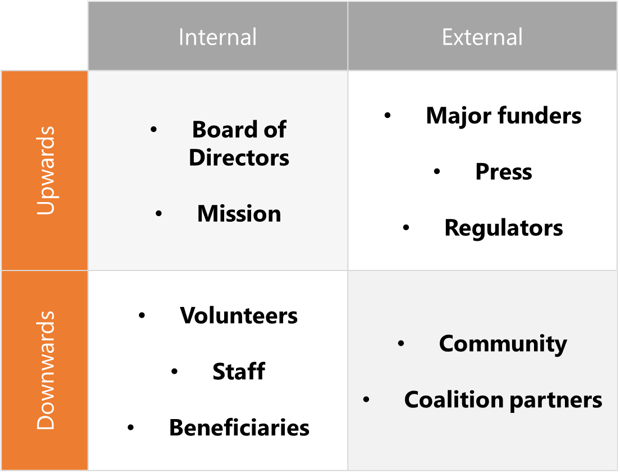3 Mission, Ethics and Accountability in the Nonprofit Sector
Learning Objectives
After reading this chapter, you should be able to:
- Define a nonprofit’s mission and vision statements.
- Explore some of the ethical issues and obligations facing nonprofit organizations and the nonprofit sector.
- Link nonprofit accountability to ethical behavior.
3.1 Chapter Introduction
Nonprofit organizations are both similar to and different from for-profit businesses and government agencies, and they also have unique attributes. Due to their tax-exempt status and requirement to behave in the public interest, one of the unique attributes of the nonprofit sector is that it is often held to a very high standard of behavior.[1] They have important ethical and legal responsibilities that they must pay attention to, lest they end up on the front page of the newspaper or harm people. Nonprofit organizations have serious obligations to the public that should always be front-of-mind, from maintaining the public trust to protecting and acting in the best interests of their constituents, clients and beneficiaries. In this chapter, we will discuss the role of a nonprofit’s mission statement and vision in guiding their behavior, the expectations for accountability nonprofits have to meet and the ethical dilemmas they must avoid.
3.2 The nonprofit mission
All nonprofit organizations have a mission statement: a “succinct description of the basic purpose of the organization.”[2] A mission statement helps to define and guide the organization’s activities. Usually only a couple of sentences long, a good mission statement should include:
- The nature of the work.
- The reason the organization exists.
- The clients/constituencies they serve.
- The organization’s principles and values.
Additionally, a good mission statement should be broad enough to allow the organization to grow, adapt and add new programs and activities. However, it shouldn’t be too broad, as the community needs a good idea of what the organization’s purpose is.

Activity
In groups, look up four different types of nonprofit organizations and find their mission statements on their websites.
- A community garden organization
- An international humanitarian organization
- A civil rights organization
- A local ballet company or symphony
- Discuss their differences and similarities. Do they discuss their: Purpose? Reason for existing? Who they serve? Their principles and values?
- Review their websites. If you were to re-write their mission statements, what would you include? As a group, write a first draft of a new mission statement for one organization.
Image: “Ballet” by Rodrigo Denubila licensed under a CC BY SA 2.0 license
3.3 Nonprofit Accountability
To be accountable is “to answer to one’s behavior.”[3] Calls for accountability in nonprofit organizations have been increasing over the past several decades, particularly when there is a scandal involving a nonprofit organization or the people who work for one (see the examples in the introduction).
Nonprofits fail to be accountable when they:
- Fail to follow their mission statement.
- Misappropriate funds (spending money on something different than what was said).
- Steal money.
- Mislead the public about what they are doing.
- Discriminate against their staff, their clients, volunteers or members of the public.
- Are wasteful.
- Fail to share financial information when asked.
- Can you think of others?
Nonprofits are also unique from other types of organizations because they are accountable to a wide variety of stakeholders. Stakeholders are those individuals or groups who are interested in what your organization is doing and whether or not it is meeting its mission.
Nonprofit stakeholders are different from those of businesses, which are most concerned about their owners or shareholders. They are also different from those of government, which is most accountable to citizens and voters. Nonprofit organizations have stakeholders both internally (volunteers, staff, board) and externally (the public, media, regulators). Additionally, they are accountable “upwards” to key stakeholders, as well as “downwards” to others. [4] The following table illustrates who these stakeholders might be:

Nonprofits are accountable for activities that they are expected to engage in (based on their mission), as well as the organization’s performance, finances and legal compliance. Helmut Anheier[5] argues that accountability includes transparency of the organization’s activities along with the behavior of their board members and employees. He argues that it’s crucial for nonprofit managers to have a “culture of transparency” to help ensure accountability. Transparency can include:
- Honesty in fundraising.
- Clear communication with donors and supporters.
- Fiscal accountability (who is responsible for what when it comes to managing the organization’s money and its accounting practices).
- Posting financial information on the organization’s website.
Some organizations, such as CharityNavigator or GuideStar, have set up websites where individuals can review available public information about organizations, including their most recent financial filings and other documents submitted to provide transparency.
3.4 Nonprofit Ethics
Running an ethical organization should be a top priority for nonprofit managers. Ethics are “well-based standards of right and wrong that prescribe what humans ought to do, usually in terms of duties, principles, specific virtues, or benefits to society.”[6] Although this definition applies to individuals, organizations can also act ethically or unethically. If organizations act unethically, they can do harm, fail to meet their missions or face scandals that can lead to significant public embarrassment, lawsuits or even being forced to close down.

Activity
Individuals and organizations generally know what clear lines are drawn in their organizations (for example, don’t steal), but staff, volunteers and board members can “get in trouble” when there is no clear distinction between right and wrong. Consider the following short scenarios. Are they potential ethical issues? Why or why not? What would you do in these situations?
- You are an organization that works on child health. Your local fast food chain would like to make a large contribution in support of your “Activate Child Health” day at the local elementary school.
- Your sports organization is offered a contribution that will double your annual budget, but you are told you can’t accept clientele who are transgender or gender non-conforming unless they are willing to participate as their “assigned gender at birth.”
- Your staff have worked very hard over the last year, particularly in recovering from the Covid-19 pandemic. You want to acknowledge their great and hard work by providing a significant bonus and throwing a party at a local country club.
- A board member suggests their company, an accounting firm, should be hired by your organization to complete and file the annual financial reports.
- Your organization is having trouble paying rent this month because donations are down. There are some leftover funds from a grant you received from a big local foundation. Your board chair suggests you use that leftover money to pay the rent.
Image: “Ethics” by masondan is licensed under CC BY-NC-SA 2.0
Unethical behavior by nonprofit organizations can include the following:
- Violation of your mission (what you say you are going to do).
- Discrimination.
- Fraud or embezzlement.
- Inappropriate fundraising practices.
- Failing to file your annual financial statements and forms on time.
- Accumulating too much profit and not spending it on the mission.
- Issues with salaries and benefits inside the organization.
- A lack of diversity among staff or board members.
- Self-dealing or self-interested behavior by board members or staff (called a conflict of interest).

Read the assigned case study, “Standards for Child Sponsorship Agencies: Part A” (2002) by Esther Scott and Dave Brown. Before you come to class, consider the following questions:
- Based on the information provided in the case, who are child sponsorship agencies accountable to? Who are they most worried about offending?
- How do you feel about their fundraising program? Do you think they are being transparent with donors about where their money is going? Why or why not?
- Make a list of the potential ethical problems you see in this case. Why did you add them to your list?
Image: “Critical Practice logo” by neil cummings is licensed under CC BY-SA 2.0
- Alnoor Ebrahim, “The Many Faces of Nonprofit Accountability,” in The Jossey-Bass Handbook of Nonprofit Leadership and Management, ed. David O. Renz (John Wiley & Sons, 2010). ↵
- Gary M. Grobman, An Introduction to the Nonprofit Sector, 4th edition (Harrisburg, Pennsylvania: White Hat Communications, 2015). ↵
- Helmut K. Anheier, Nonprofit Organizations: Theory, Management, Policy, 2nd ed. (New York: Routledge, 2014), http://books.google.com/books?hl=en&lr=&id=FCpc6YdSAT0C&oi=fnd&pg=PP1&dq="edition published in the Taylor and Francis e-Library," "purchase your own copy of this or any of Taylor & Francis or" "2005 Helmut K." "known or hereafter invented, including photocopying and" &ots=XwI7vdB88A&sig=SK_snvwMXOI0aEPXu2Kj0Q3O73U. ↵
- Ebrahim, “The Many Faces of Nonprofit Accountability.” ↵
- Anheier, Nonprofit Organizations. ↵
- Craig E. Johnson, Meeting the Ethical Challenges of Leadership: Casting Light Or Shadow (SAGE Publications, 2007), 10. ↵

